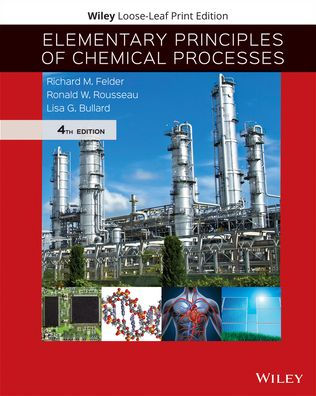
Elementary Principles of Chemical Processes
704
Elementary Principles of Chemical Processes
704(4th ed.)
-
PICK UP IN STORECheck Availability at Nearby Stores
Available within 2 business hours
Related collections and offers
Overview

Product Details
| ISBN-13: | 9781119498636 |
|---|---|
| Publisher: | Wiley |
| Publication date: | 08/11/2020 |
| Edition description: | 4th ed. |
| Pages: | 704 |
| Sales rank: | 643,281 |
| Product dimensions: | 7.80(w) x 9.90(h) x 1.10(d) |
About the Author
RICHARD M. FELDER has authored or co-authored over 100 papers on chemical process engineering and engineering education, and presents seminars, workshops, and short courses on both topics to industrial and research institutions and universities in the United State, Europe, and South America. Since 1990 he has co-directed the National Effective Teaching Institute under the auspices of the American Society for Engineering Education. He has won numerous awards for his contributions to engineering education.
RONALD W. ROUSSEAU is Professor of Chemical Engineering at the Georgia Institute of Technology. His Teaching and research activities focus on separation and purification, and he has been honored for his work in crystallization. He has published extensively and given lectu5res and short courses in Asia, Australia, Europe, the Middle East, and throughout the United States. An active promoter of university-industry interactions, he has served as Chair of the Council for Chemical Research and consultant to more than 50 organizations.
Table of Contents
About the Authors iiiPreface to the Fourth Edition iv
Notes to Instructors v
Digital Resources and WileyPLUS vii
Postscript: Introduction to an Author viii
Nomenclature ix
Glossary xi
Part 1 Engineering Problem Analysis 1
Chapter 1 What Some Chemical Engineers Do for a Living 3
Chapter 2 Introduction to Engineering Calculations 5
2.0 Learning Objectives 5
2.1 Units and Dimensions 6
2.2 Conversion of Units 7
2.3 Systems of Units 8
2.4 Force and Weight 10
2.5 Numerical Calculation and Estimation 12
2.6 Dimensional Homogeneity and Dimensionless Quantities 19
2.7 Process Data Representation and Analysis 21
2.8 Summary 29
Problems 30
Chapter 3 Processes and Process Variables 45
3.0 Learning Objectives 45
3.1 Mass and Volume 46
3.2 Flow Rate 48
3.3 Chemical Composition 50
3.4 Pressure 57
3.5 Temperature 64
3.6 Summary 67
Problems 68
Part 2 Material Balances 89
Chapter 4 Fundamentals of Material Balances 91
4.0 Learning Objectives 91
4.1 Process Classification 92
4.2 Balances 93
4.3 Material Balance Calculations 97
4.4 Balances on Multiple-Unit Processes 116
4.5 Recycle and Bypass 122
4.6 Chemical Reaction Stoichiometry 129
4.7 Balances on Reactive Processes 140
4.8 Combustion Reactions 161
4.9 Some Additional Considerations about Chemical Processes 169
4.10 Summary 172
Problems 173
Chapter 5 Single-Phase Systems 216
5.0 Learning Objectives 217
5.1 Liquid and Solid Densities 218
5.2 Ideal Gases 220
5.3 Equations of State for Nonideal Gases 228
5.4 The Compressibility-Factor Equation of State 235
5.5 Summary 242
Problems 242
Chapter 6 Multiphase Systems 273
6.0 Learning Objectives 275
6.1 Single-Component Phase Equilibrium 276
6.2 The Gibbs Phase Rule 282
6.3 Gas–Liquid Systems: One Condensable Component 284
6.4 Multicomponent Gas–Liquid Systems 290
6.5 Solutions of Solids in Liquids 299
6.6 Equilibrium Between Two Liquid Phases 307
6.7 Adsorption on Solid Surfaces 311
6.8 Summary 314
Problems 316
Part 3 Energy Balances 353
Chapter 7 Energy and Energy Balances 355
7.0 Learning Objectives 356
7.1 Forms of Energy: The First Law of Thermodynamics 357
7.2 Kinetic and Potential Energy 359
7.3 Energy Balances on Closed Systems 360
7.4 Energy Balances on Open Systems at Steady State 362
7.5 Tables of Thermodynamic Data 367
7.6 Energy Balance Procedures 372
7.7 Mechanical Energy Balances 375
7.8 Summary 380
Problems 382
Chapter 8 Balances on Nonreactive Processes 402
8.0 Learning Objectives 402
8.1 Elements of Energy Balance Calculations 403
8.2 Changes in Pressure at Constant Temperature 411
8.3 Changes in Temperature 412
8.4 Phase-Change Operations 424
8.5 Mixing and Solution 443
8.6 Summary 454
Problems 456
Chapter 9 Balances on Reactive Processes 493
9.0 Learning Objectives 494
9.1 Heats of Reaction 494
9.2 Measurement and Calculation of Heats of Reaction: Hess’s Law 499
9.3 Formation Reactions and Heats of Formation 501
9.4 Heats of Combustion 503
9.5 Energy Balances on Reactive Processes 504
9.6 Fuels and Combustion 519
9.7 Summary 529
Problems 531
Chapter 10 Balances on Transient Processes 570
10.0 Learning Objectives 570
10.1 The General Balance Equation . . . Again 570
10.2 Material Balances 575
10.3 Energy Balances on Single-Phase Nonreactive Processes 582
10.4 Simultaneous Transient Balances 587
10.5 Summary 590
Problems 591
Appendix A Computational Techniques 607
A.1 The Method of Least Squares 607
A.2 Iterative Solution of Nonlinear Algebraic Equations 610
A.3 Numerical Integration 623
Appendix B Physical Property Tables 627
B.1 Selected Physical Property Data 628
B.2 Heat Capacities 635
B.3 Vapor Pressure of Water 638
B.4 Antoine Equation Constants 640
B.5 Properties of Saturated Steam: Temperature Table 642
B.6 Properties of Saturated Steam: Pressure Table 644
B.7 Properties of Superheated Steam 650
B.8 Specific Enthalpies of Selected Gases: SI Units 652
B.9 Specific Enthalpies of Selected Gases: U.S. Customary Units 652
B.10 Atomic Heat Capacities for Kopp’s Rule 653
B.11 Integral Heats of Solution and Mixing at 25°C 653
Answers to Test Yourselves 654
Answers to Selected Problems 662
Index 667
